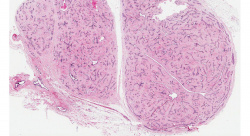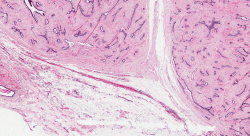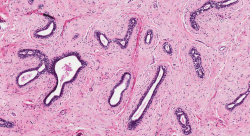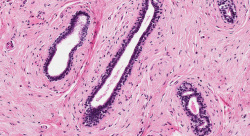Difference between revisions of "IPLab:Lab 7:Fibroadenoma"
Seung Park (talk | contribs) (Created page with "== Images == <gallery heights="250px" widths="250px"> File:IPLab7Fibroadenoma1.jpg|This low-power photomicrograph of the surgical specimen demonstrates three ovoid, well-circu...") |
(→Images) |
||
| (9 intermediate revisions by one other user not shown) | |||
| Line 1: | Line 1: | ||
| + | == Clinical Summary == | ||
| + | Four months prior to admission, this 25-year-old female became aware of a lump beneath the areola of her right breast. Physical examination confirmed the presence of an approximately 3 cm movable, rubbery mass. An aspiration was attempted but did not yield any fluid or cells. At the time of surgical exploration, a well-circumscribed mass was identified and removed. | ||
| + | |||
== Images == | == Images == | ||
<gallery heights="250px" widths="250px"> | <gallery heights="250px" widths="250px"> | ||
| − | File: | + | File:IPLab7Fibroadenoma1b.jpg|This low-power photomicrograph of the surgical specimen demonstrates two ovoid, well-circumscribed nodules surrounded by fibroadipose tissue. |
| − | File: | + | File:IPLab7Fibroadenoma2b.jpg|In this higher magnification you can see the solid parenchyma with numerous variable sized glandular spaces. |
| − | File: | + | File:IPLab7Fibroadenoma3b.jpg|This is a higher magnification of the fibroadenoma showing the dense stroma of the tumor surrounding the irregularly shaped ducts. |
| − | + | File:IPLab7Fibroadenoma4b.jpg|This is a high magnification of the fibroadenoma showing the dense stroma of the tumor surrounding the irregularly shaped ducts. The ducts are lined by two cell layers, one of cuboidal, two columnar cells (inner layer) and an outer layer of flattened cells with hyperchromatic nuclei (myoepithelial cells). | |
| − | File: | ||
| − | |||
| − | |||
</gallery> | </gallery> | ||
| + | |||
| + | == Virtual Microscopy == | ||
| + | <peir-vm>IPLab7Fibroadenoma</peir-vm> | ||
| + | |||
| + | == Study Questions == | ||
| + | * <spoiler text="What tissue makes up the neoplastic portion of the fibroadenoma?">Fibroadenomas are new growths of glandular and stromal tissues. Cytogenetic studies have shown that in some cases only the fibrous (stromal) component is clonal. These tumors appear to arise from the specialized intralobular stroma.</spoiler> | ||
| + | * <spoiler text="At what age do fibroadenomas usually occur?">They occur at any age within the reproductive period of life, but they are somewhat more common before age 30.</spoiler> | ||
| + | * <spoiler text="Why do fibroadenomas cause problems in pre-menopausal women?">The epithelium of the fibroadenoma is responsive to hormones. Slight increases in size may occur during the late phases of each menstrual cycle, and pregnancy may stimulate growth and lactation. Postmenopausally, regression or calcification may result. There is also a slightly increased risk for development of breast carcinoma.</spoiler> | ||
| + | |||
| + | == Additional Resources == | ||
| + | === Reference === | ||
| + | * [http://emedicine.medscape.com/article/781116-overview eMedicine Medical Library: Breast Abscess and Masses] | ||
| + | * [http://www.merckmanuals.com/professional/gynecology_and_obstetrics/breast_disorders/evaluation_of_breast_disorders.html Merck Manual: Evaluation of Breast Disorders] | ||
| + | |||
| + | === Journal Articles === | ||
| + | * Yilmaz E, Sal S, Lebe B. [http://www.ncbi.nlm.nih.gov/pubmed/11972459 Differentiation of phyllodes tumors versus fibroadenomas]. ''Acta Radiol'' 2002 Jan;43(1):34-9. | ||
| + | * Hogge JP, De Paredes ES, Magnant CM, Lage J. [http://www.ncbi.nlm.nih.gov/pubmed/11348301 Imaging and management of breast masses during pregnancy and lactation]. ''Breast J'' 1999 Jul;5(4):272-283. | ||
| + | |||
| + | === Images === | ||
| + | * [{{SERVER}}/library/index.php?/tags/2147-fibroadenoma PEIR Digital Library: Fibroadenoma Images] | ||
| + | |||
| + | == Related IPLab Cases == | ||
| + | * [[IPLab:Lab 7:IDC|Lab 7: Breast: Infiltrating Ductal Carcinoma]] | ||
{{IPLab 7}} | {{IPLab 7}} | ||
[[Category: IPLab:Lab 7]] | [[Category: IPLab:Lab 7]] | ||
Latest revision as of 01:08, 9 July 2020
Contents
Clinical Summary
Four months prior to admission, this 25-year-old female became aware of a lump beneath the areola of her right breast. Physical examination confirmed the presence of an approximately 3 cm movable, rubbery mass. An aspiration was attempted but did not yield any fluid or cells. At the time of surgical exploration, a well-circumscribed mass was identified and removed.
Images
This is a high magnification of the fibroadenoma showing the dense stroma of the tumor surrounding the irregularly shaped ducts. The ducts are lined by two cell layers, one of cuboidal, two columnar cells (inner layer) and an outer layer of flattened cells with hyperchromatic nuclei (myoepithelial cells).
Virtual Microscopy
Study Questions
Additional Resources
Reference
Journal Articles
- Yilmaz E, Sal S, Lebe B. Differentiation of phyllodes tumors versus fibroadenomas. Acta Radiol 2002 Jan;43(1):34-9.
- Hogge JP, De Paredes ES, Magnant CM, Lage J. Imaging and management of breast masses during pregnancy and lactation. Breast J 1999 Jul;5(4):272-283.



